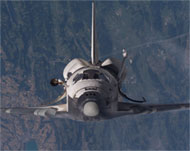Nasa remembers shuttle disaster
The US space agency Nasa is marking the 20th anniversary of the Challenger shuttle disaster with the shuttle programme still overshadowed by doubts over its safety and value.

Saturday’s anniversary will be commemorated by a ceremony at the Kennedy Space Centre in Florida attended by families of the seven Challenger astronauts.
The disaster that unfolded before crowds gathered to watch the launch and in front of millions on live television on 28 January 1986 shocked the country and remains engraved on the national psyche.
The then president, Ronald Reagan, was visibly shaken, cancelling his State of the Union address scheduled later the same day.
The disaster claimed the lives of two women – including Christa McAuliffe, who was to have been the first non-professional astronaut in space and instead became a symbol of the Challenger tragedy.
The launch, originally scheduled for 22 January, came on 28 January at 11.38am under a brilliant blue sky and near-freezing temperatures.
Fireball
 |
|
Challenger clears the tower, |
All appeared normal in the first moments after liftoff, the 25th since the shuttle programme began in April 1981.
The pilot, Michael Smith, could be heard confirming with excitement that the shuttle was on its way.
But after 73 seconds, at an altitude of 14,000 meters (46,200 feet), Challenger exploded in an enormous fireball of hydrogen and liquid oxygen.
Its two booster rockets left a trail of flame and smoke, forming an immense “V” in the sky.
After a moment of hesitation, the Nasa announcer said mission control had lost contact with the shuttle. Following 40 seconds of silence, he confirmed in a solemn voice what had become clear for everyone watching.
One week later, a presidential commission was formed to investigate the accident and quickly concluded that it was caused by a defective seal on a solid rocket booster.
Credibility questioned
Two years later, Nasa carried out an elaborate review of its rocket design and spent more than $2 billion on modifications.
But the credibility of the US space agency was again called into question after Columbia disintegrated during re-entry into the Earth’s atmosphere in February 2003, killing another seven astronauts.
 |
|
The shuttle programme remains |
A piece of loose insulating foam punctured the edge of the shuttle’s left wing, allowing hot gases to enter the spacecraft and causing the shuttle to break apart during re-entry.
Despite yet more modifications at a cost of $1.5 billion, the space shuttle Discovery also lost a large piece of insulation during its launch in July 2005, the first shuttle flight since the Columbia catastrophe.
Growing criticism
Though it caused no accident, it forced Nasa to ground its three shuttles at least until May 2006, in an atmosphere of growing criticism that the programme has become a dead end for space flight.
Aside from the Challenger and Columbia accidents, Nasa has come close to disaster on other flights due to loose insulation and ice, according to investigators.
Reinforcing the sense that the shuttle fleet is past its prime, President George Bush announced last year that the programme would end in 2010 upon completion of the International Space Station, which requires an additional 17 missions.
Under the plan, the shuttle would be replaced by the new Crew Exploration Vehicle (CEV), with its first mission set for 2012 and missions to the Moon and eventually Mars scheduled for 2018.